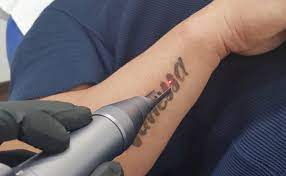Uncover the Secrets of Laser Tattoo Removal

Laser tattoo removal has emerged as one of the most effective methods for erasing unwanted tattoos. While it is a well-known technique, several aspects of the process may not be immediately apparent. Understanding these "secrets" can help you make informed decisions and achieve the best results. Here’s an in-depth look at the hidden elements of Laser Tattoo Removal in Dubai that can impact its effectiveness and your overall experience.
1. The Laser Technology
The choice of laser technology plays a crucial role in the effectiveness of tattoo removal. Here's what you need to know:
- Picosecond vs. Q-Switched Lasers: Picosecond lasers emit ultra-short pulses that break down ink particles into smaller fragments compared to Q-switched lasers. This can lead to faster removal with potentially fewer treatments. Q-switched lasers, however, are effective for a wide range of colors and are well-established in tattoo removal.
- Multi-Wavelength Systems: Some lasers use multiple wavelengths to target a broader spectrum of ink colors. This versatility is particularly useful for multi-colored tattoos, where different pigments require different wavelengths for effective treatment.
2. Ink Composition and Depth
The composition and depth of the tattoo ink can significantly affect the removal process:
- Ink Colors: Different ink colors absorb different wavelengths of light. Black ink is typically easier to remove because it absorbs most wavelengths, while colors like green and blue may require specialized lasers.
- Ink Depth: Tattoos with deeper ink penetration into the skin can be more challenging to remove. The depth at which the ink was deposited affects how well it is broken down and cleared by the body’s lymphatic system.
3. Skin Type and Condition
Your skin type and overall skin condition can influence the outcome of the removal process:
- Skin Tone: Darker skin tones may absorb more laser energy, which can increase the risk of pigmentation changes or scarring. Laser practitioners often adjust settings to minimize risks for different skin tones.
- Skin Health: Healthy skin heals better and responds more effectively to laser treatments. Maintaining good skin health and avoiding sun exposure before and after treatment can improve results and reduce complications.
4. The Importance of Aftercare
Proper aftercare is essential for maximizing the effectiveness of laser tattoo removal:
- Healing Time: Allowing adequate time for your skin to heal between sessions is crucial. The treated area should be kept clean, protected from the sun, and moisturized as instructed by your practitioner.
- Avoiding Irritants: Avoid using harsh skincare products or exposing the treated area to irritants, as these can hinder the healing process and affect the outcome.
5. The Role of the Immune System
Your body's immune system plays a vital role in the tattoo removal process:
- Ink Clearance: After the laser treatment, the body’s lymphatic system works to clear the fragmented ink particles. A healthy immune system supports this natural process and helps achieve better results.
- Individual Variations: Everyone’s immune response is different. Factors such as overall health, lifestyle, and genetic predisposition can affect how quickly and effectively the ink is removed.
6. Managing Expectations
Understanding what to expect from laser tattoo removal can help manage your expectations:
- Gradual Process: Tattoo removal is a gradual process that typically requires multiple sessions. Complete removal may take several months, and results vary based on tattoo size, color, and individual skin response.
- Possible Residual Ink: While most tattoos can be significantly faded or removed, some residual ink may remain, especially for tattoos with multiple colors or deep pigments.
7. Choosing the Right Practitioner
Selecting a qualified and experienced practitioner is key to achieving optimal results:
- Experience and Expertise: Look for a practitioner with extensive experience in laser tattoo removal and a thorough understanding of different laser technologies. They should be able to tailor the treatment to your specific tattoo and skin type.
- Reputation and Reviews: Research the practitioner’s reputation and read reviews from previous patients. A well-regarded practitioner with positive feedback is more likely to provide effective and safe treatment.
8. The Impact of Tattoo Age
The age of the tattoo can affect the removal process:
- Older Tattoos: Older tattoos may be easier to remove as the ink may have already started to break down or fade naturally over time. However, the ink may also have settled deeper into the skin.
- New Tattoos: New tattoos might require more sessions due to the ink's fresh application and depth. Additionally, new tattoos can be more sensitive and may require a longer healing time between sessions.
9. The Role of Laser Settings
The settings used during the laser treatment are crucial for achieving the best results:
- Energy Levels: Adjusting the energy levels of the laser based on the tattoo’s characteristics helps ensure effective removal while minimizing the risk of skin damage.
- Pulse Duration: The duration of the laser pulses can be adjusted to target specific ink particles. Shorter pulses are generally used for fine ink particles, while longer pulses may be used for larger particles.
10. Combining Treatments
In some cases, combining laser tattoo removal with other treatments can enhance results:
- Skin Resurfacing: Procedures like fractional laser resurfacing can improve skin texture and appearance following tattoo removal, especially if there are residual pigment or texture issues.
- Topical Treatments: Certain topical treatments or medications may support skin healing and improve overall results.
Conclusion
Understanding the secrets behind laser tattoo removal can help you make informed decisions and achieve the best possible results. From choosing the right technology and managing expectations to adhering to aftercare and selecting a skilled practitioner, each element plays a critical role in the effectiveness of the treatment. By uncovering these aspects, you can approach your tattoo removal journey with confidence and clarity, working towards a clearer, tattoo-free canvas.